
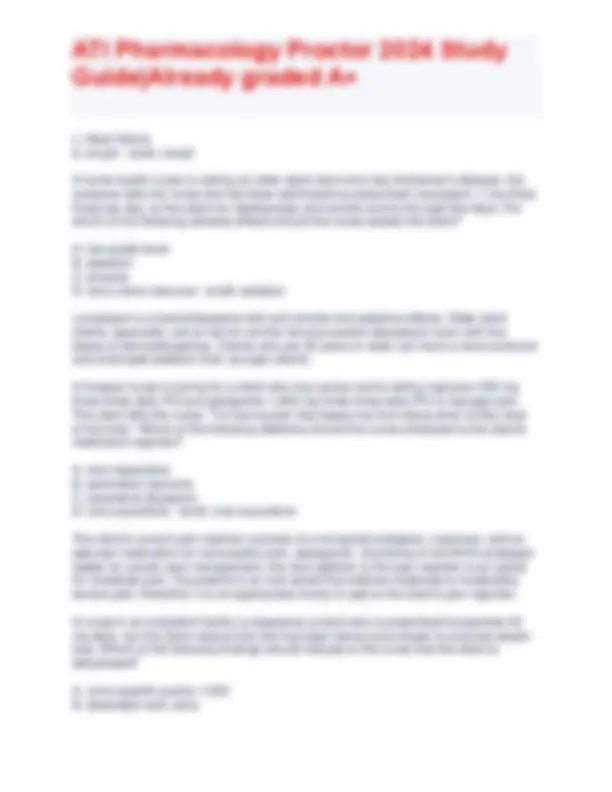
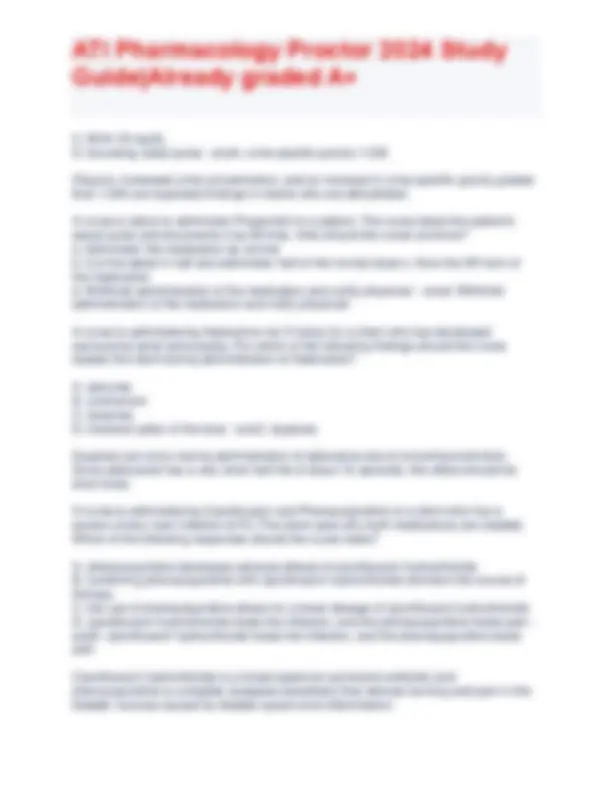
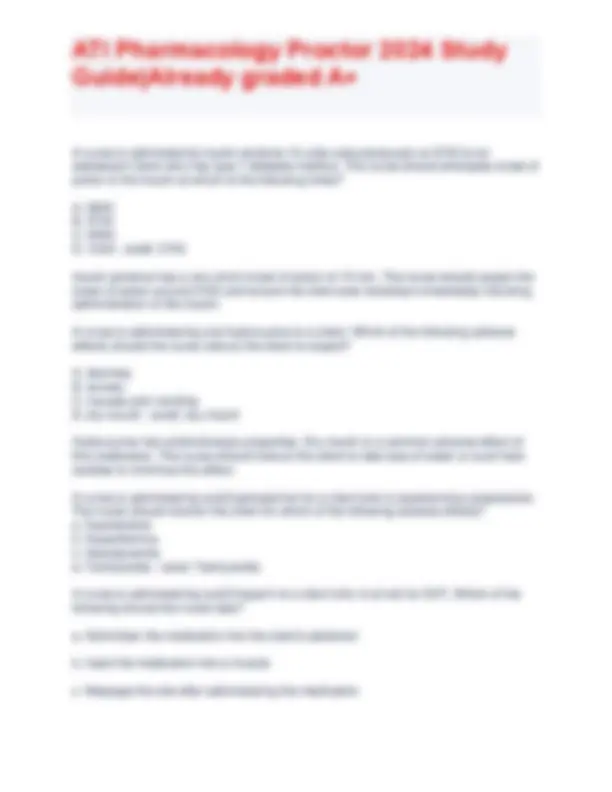
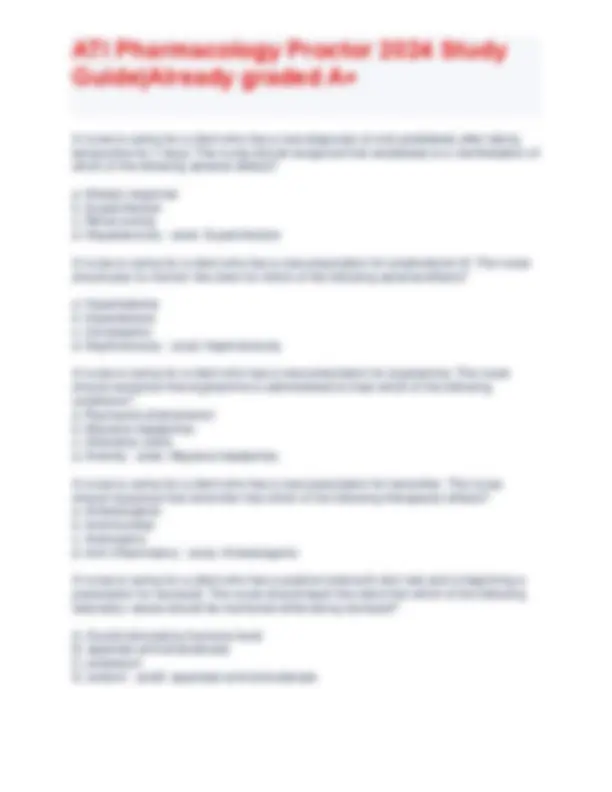
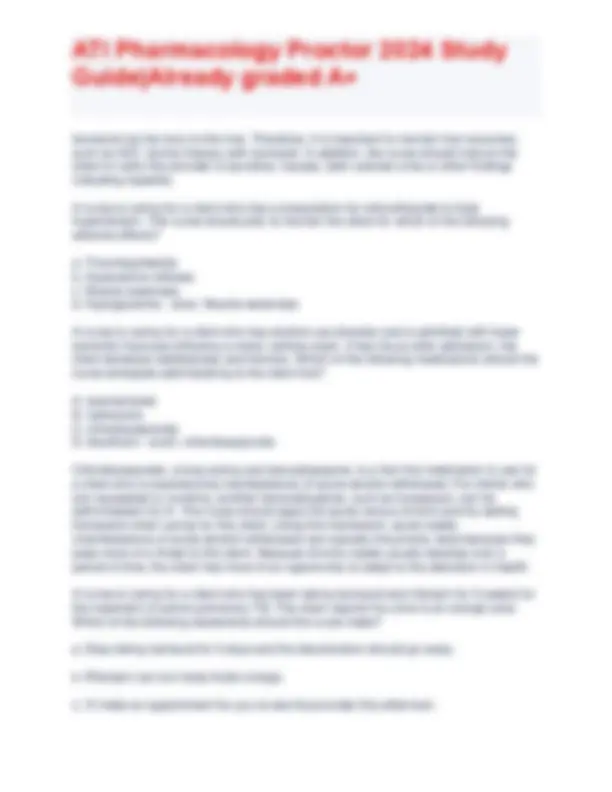
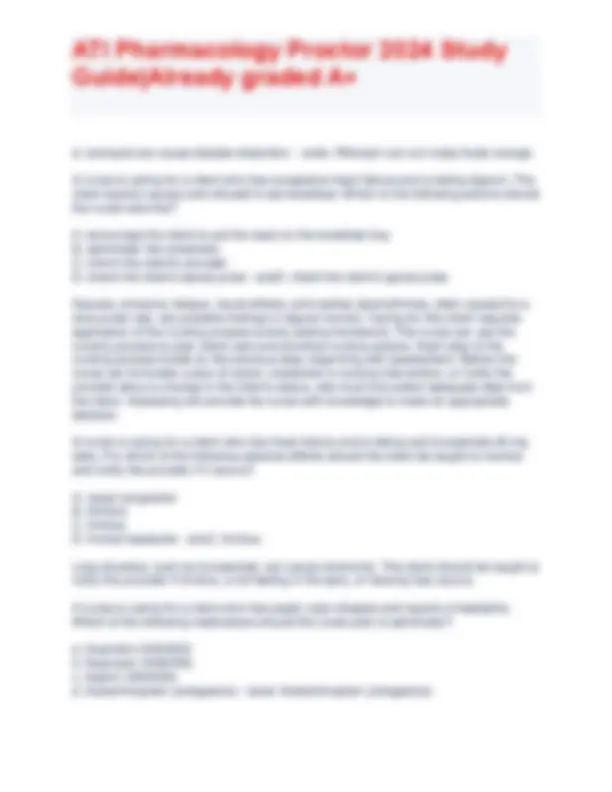
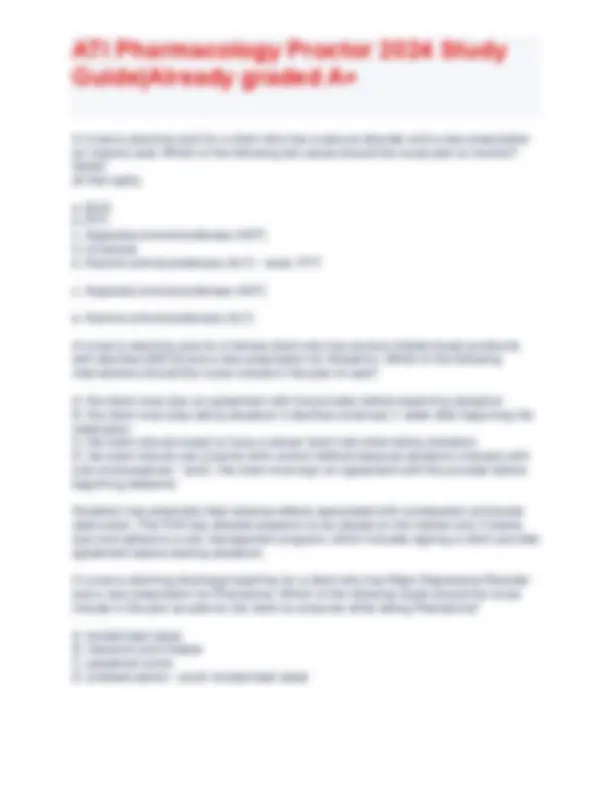
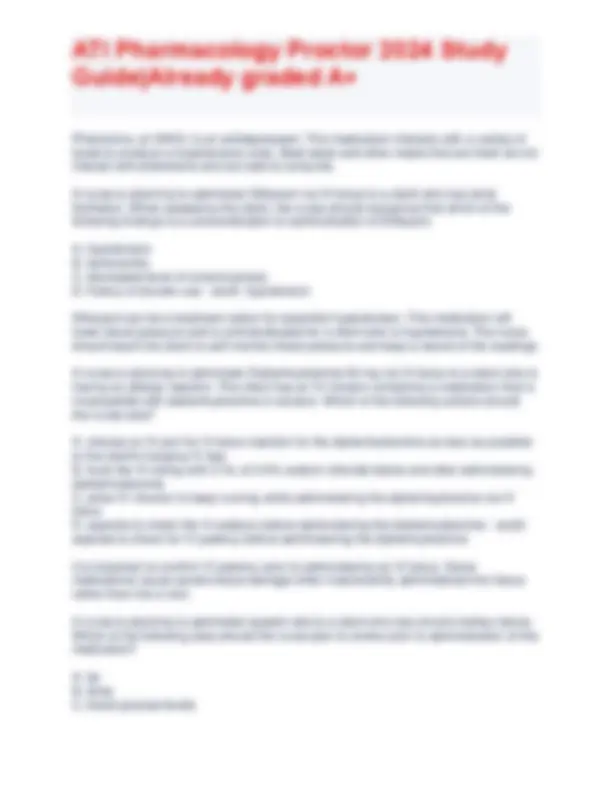
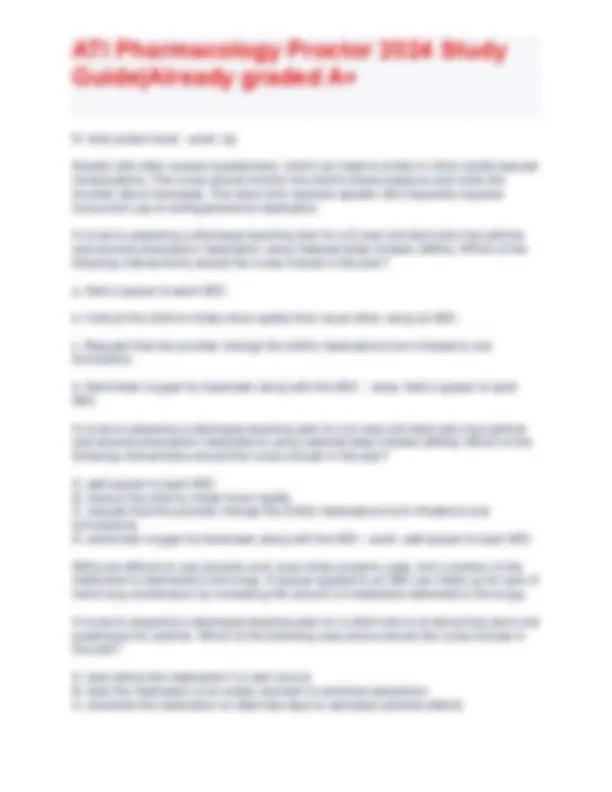
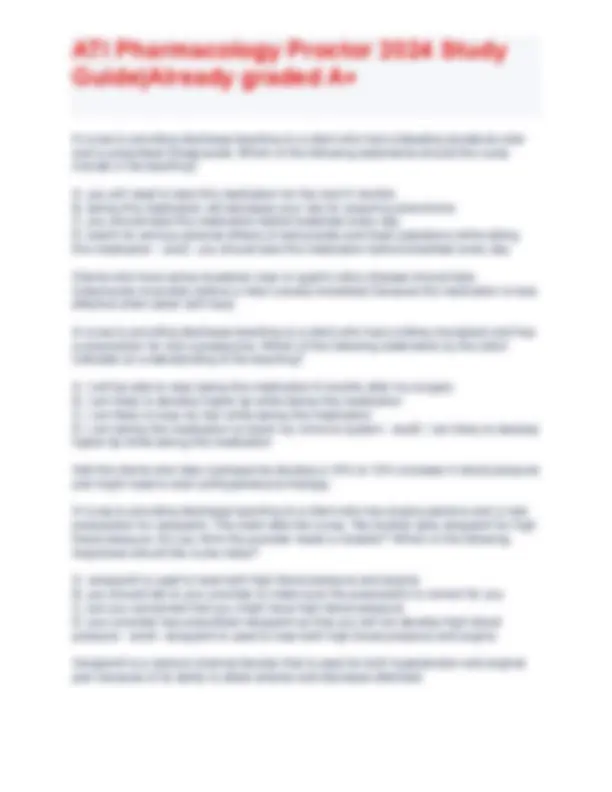
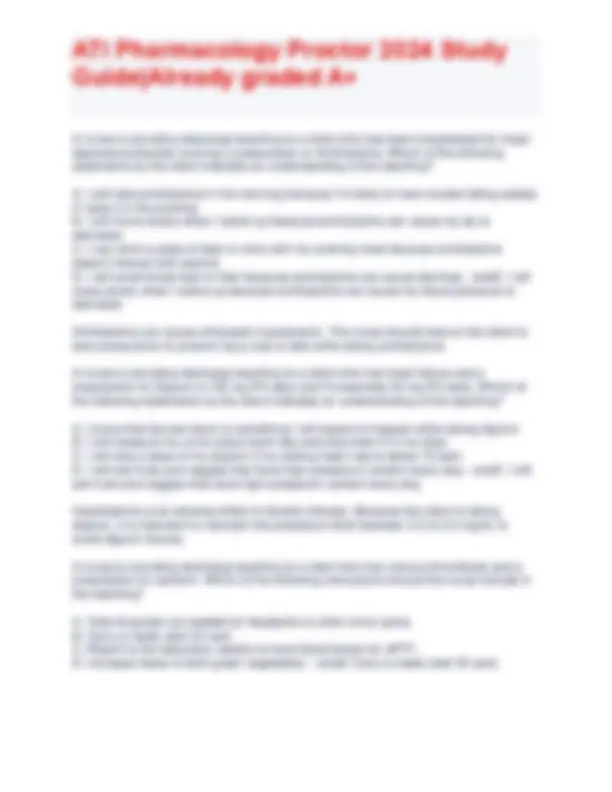
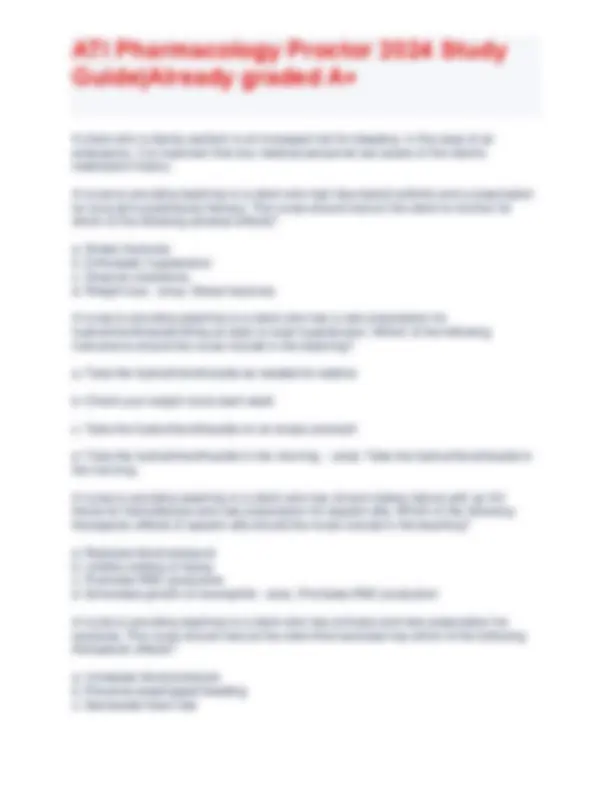
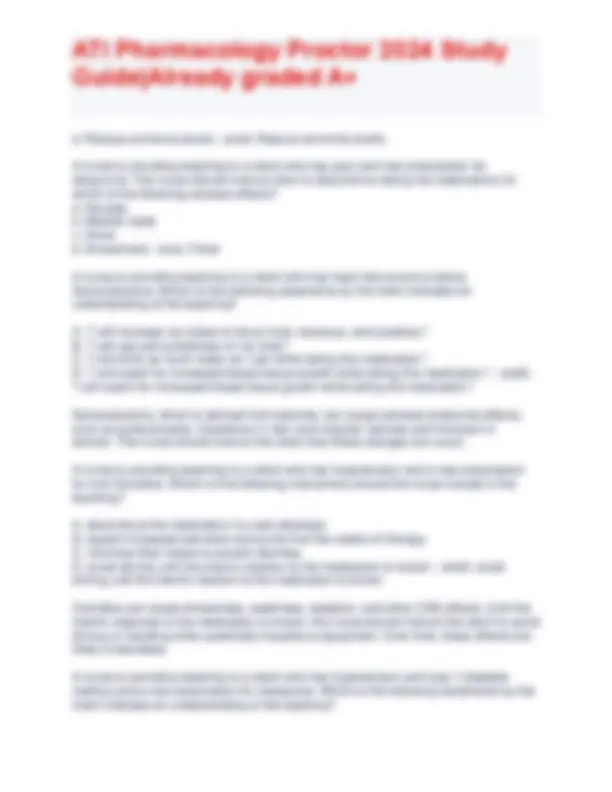
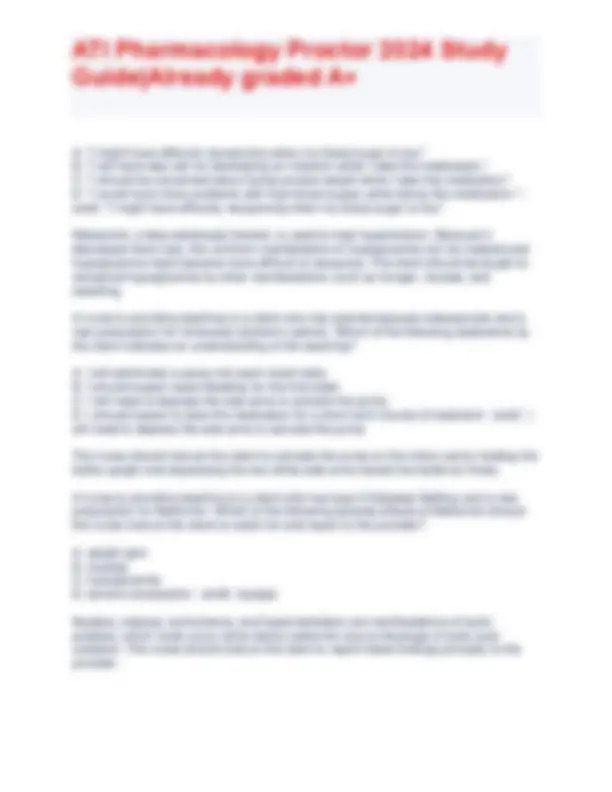

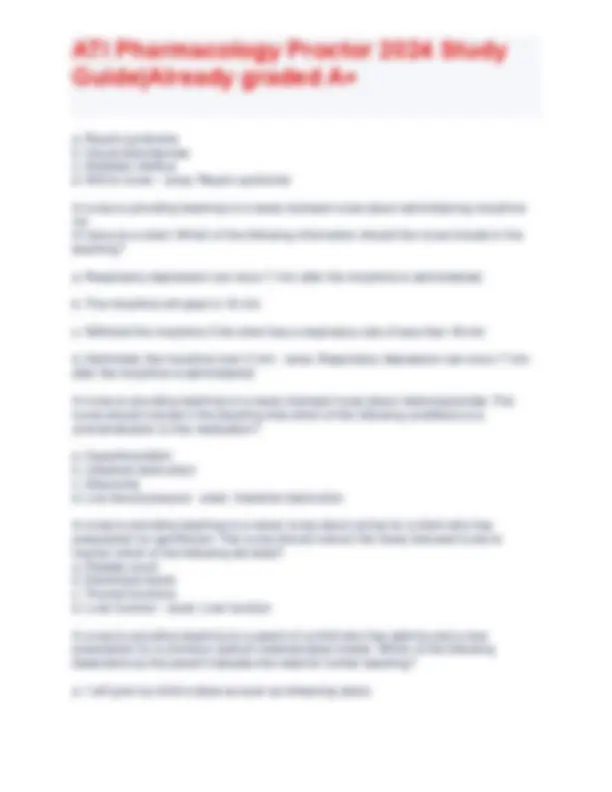
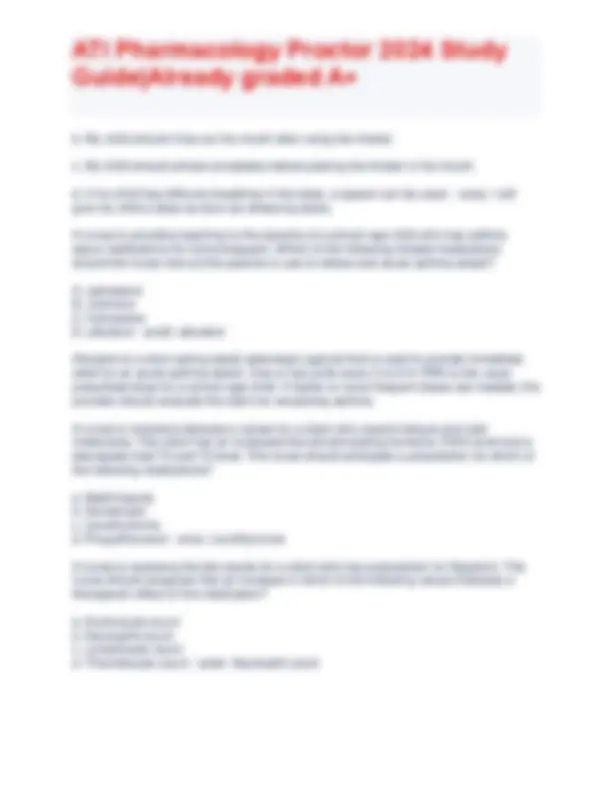
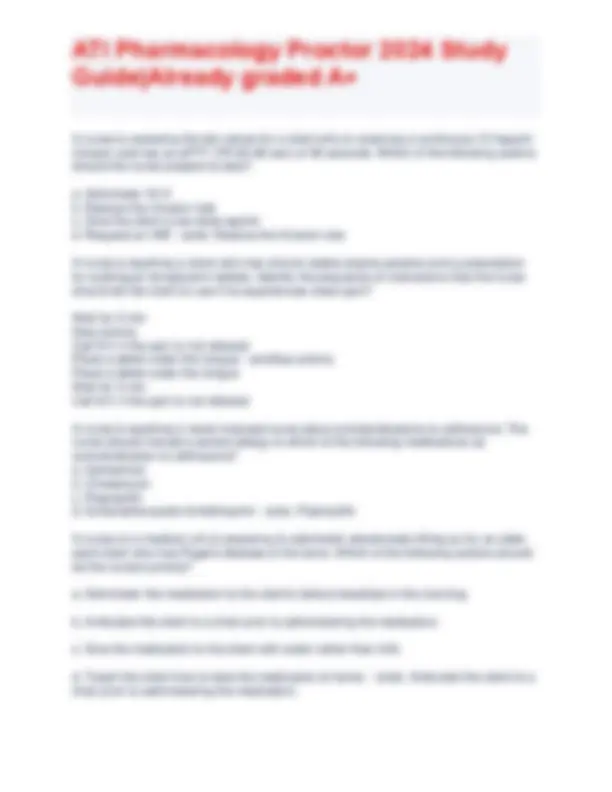
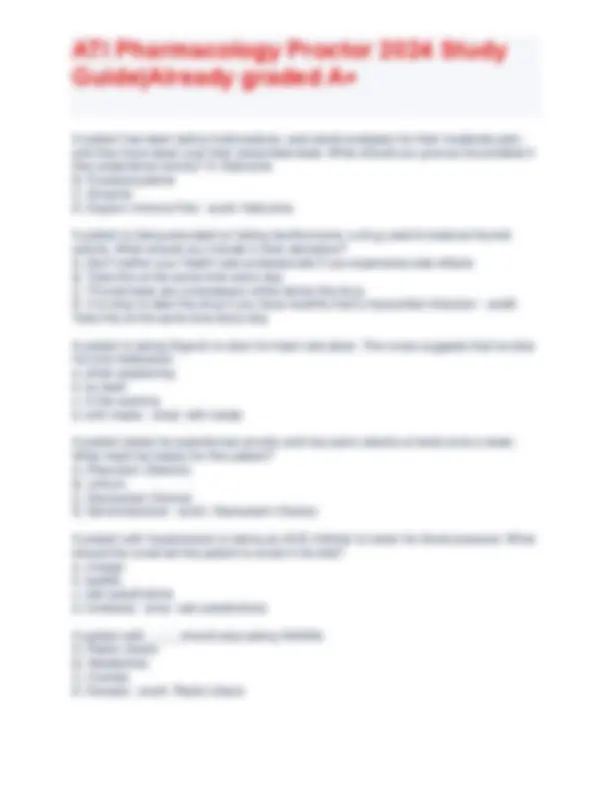
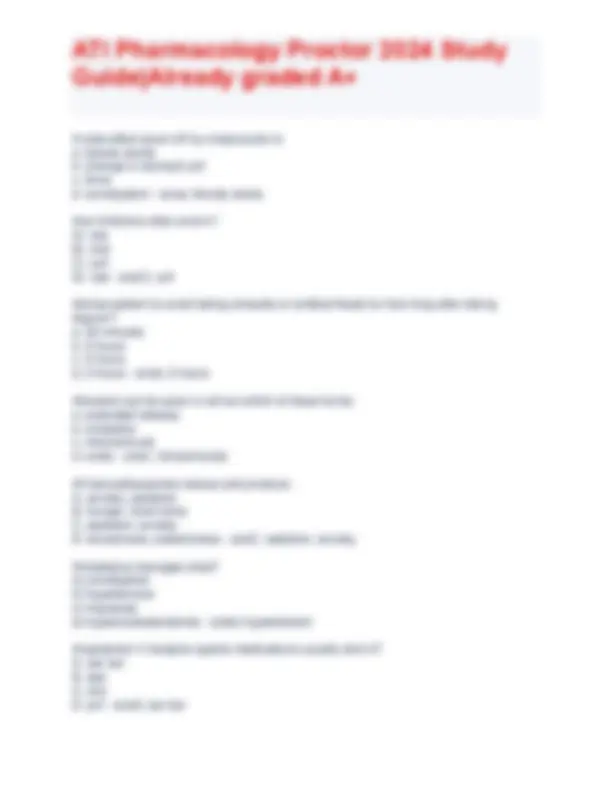
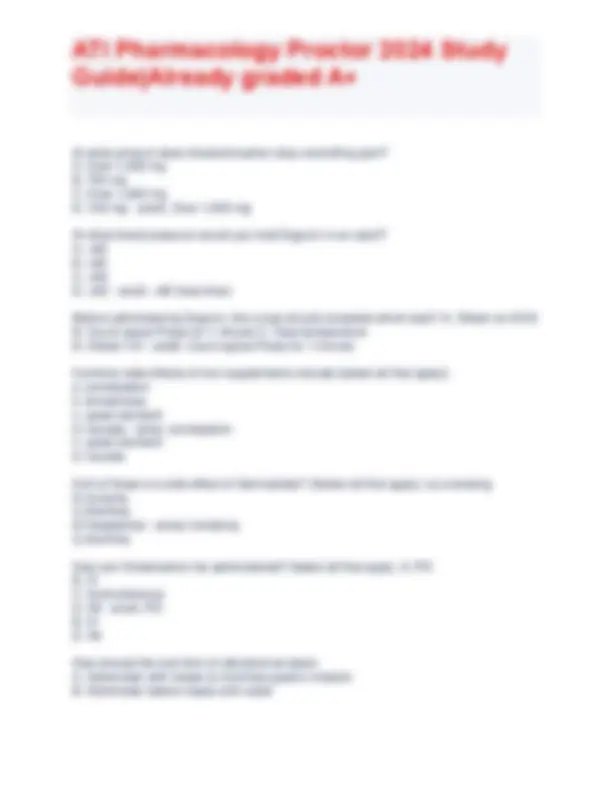
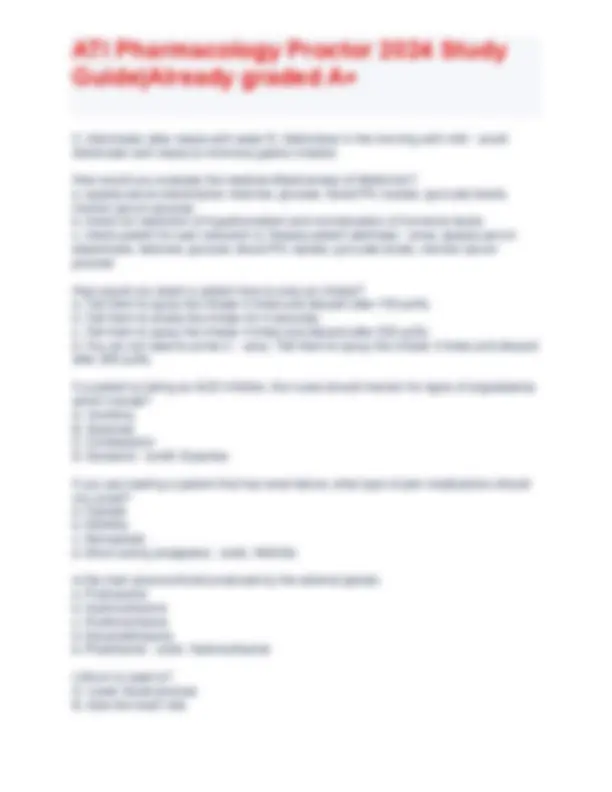
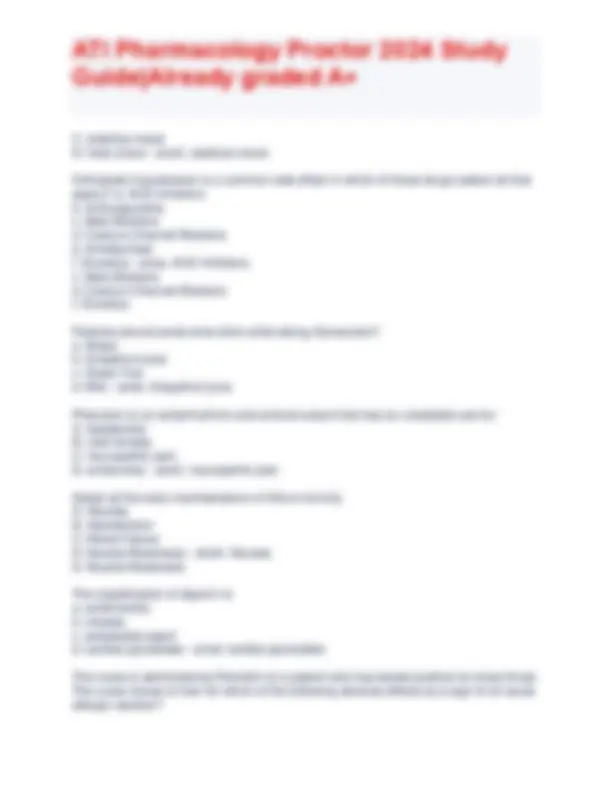
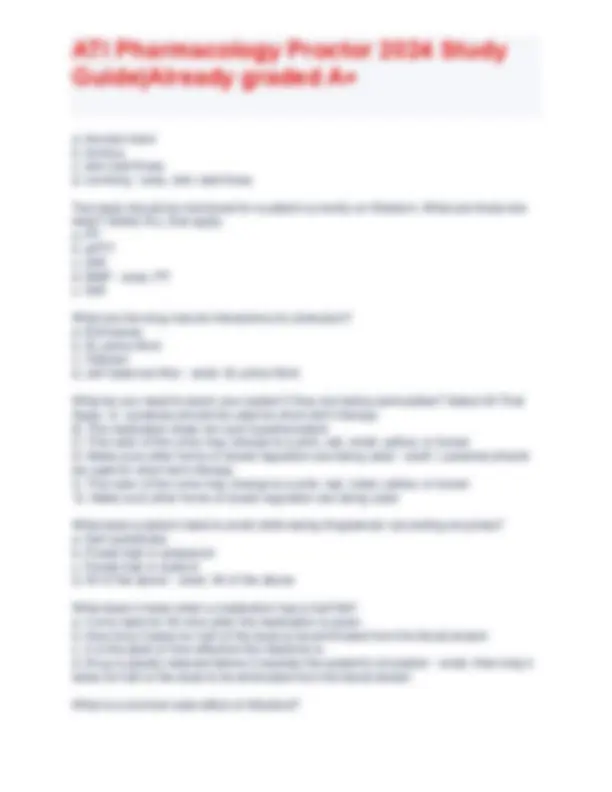
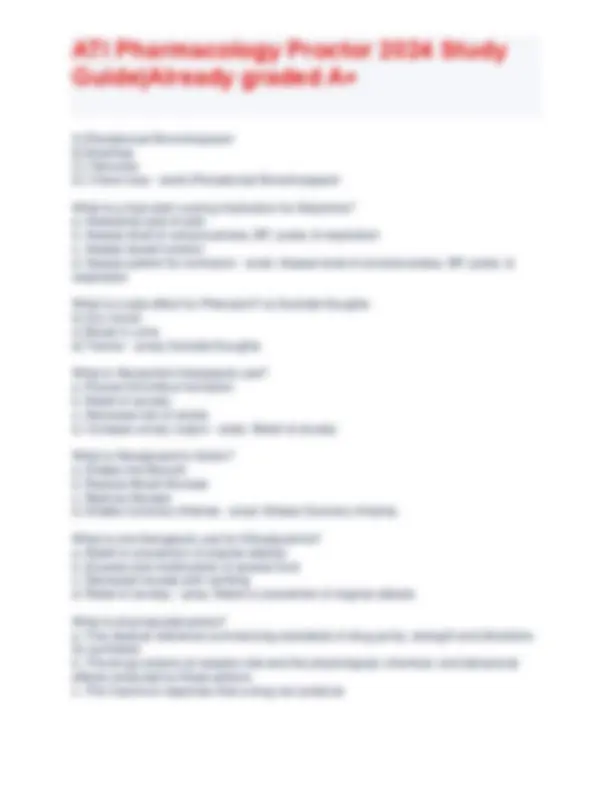
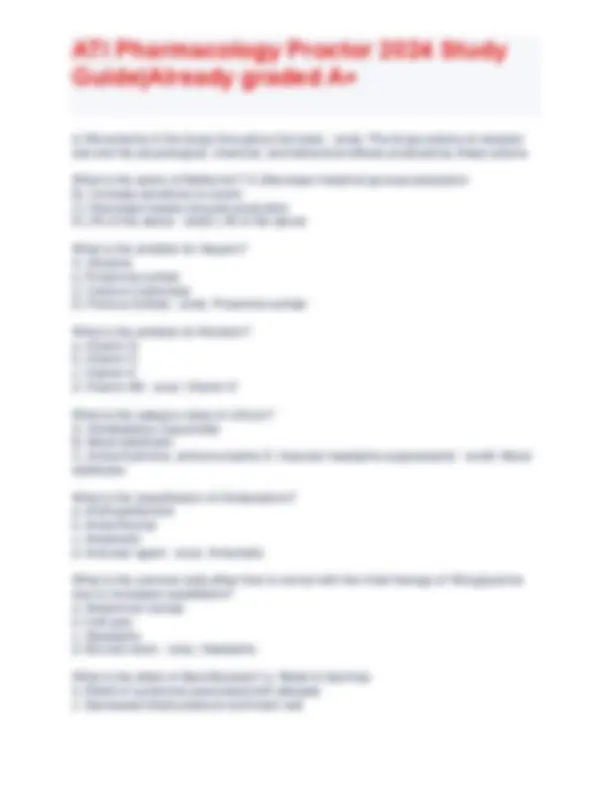
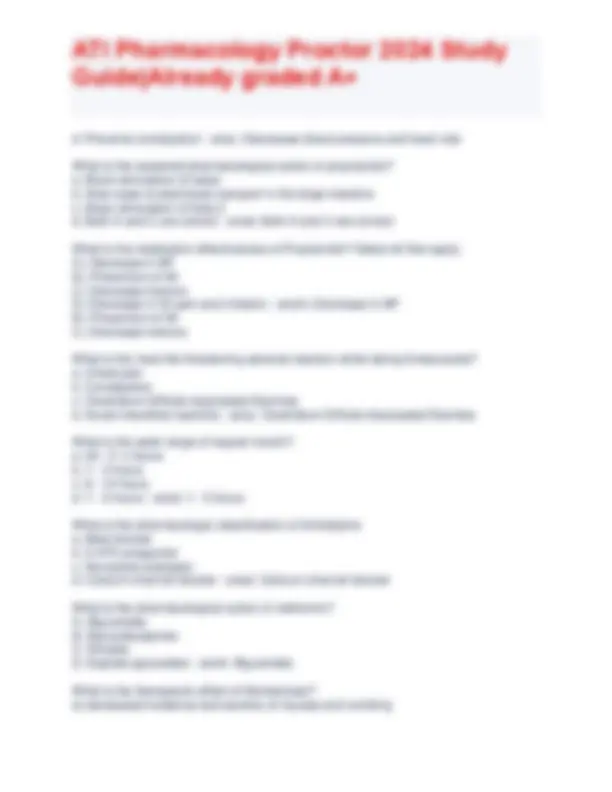
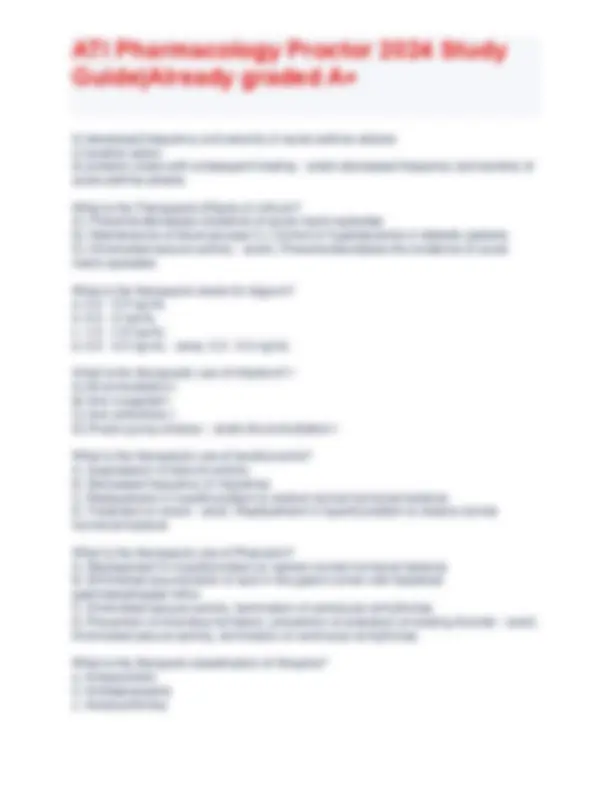
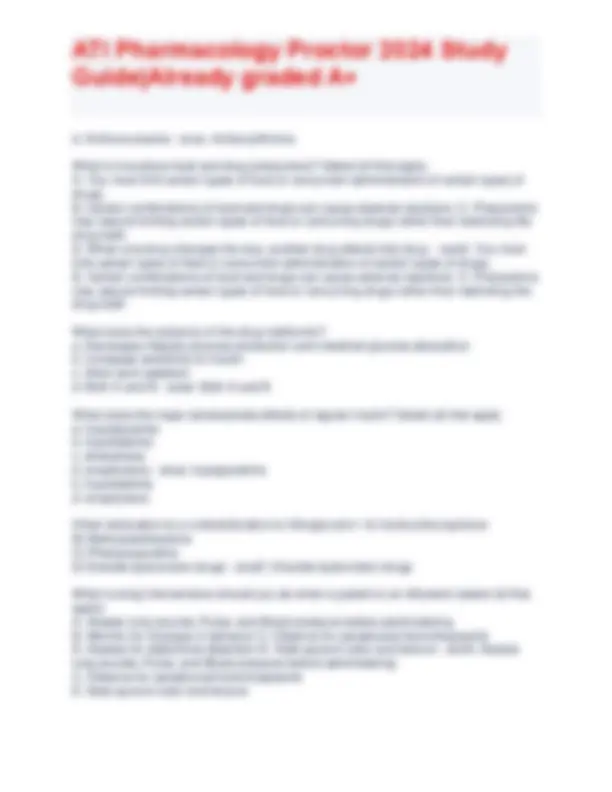
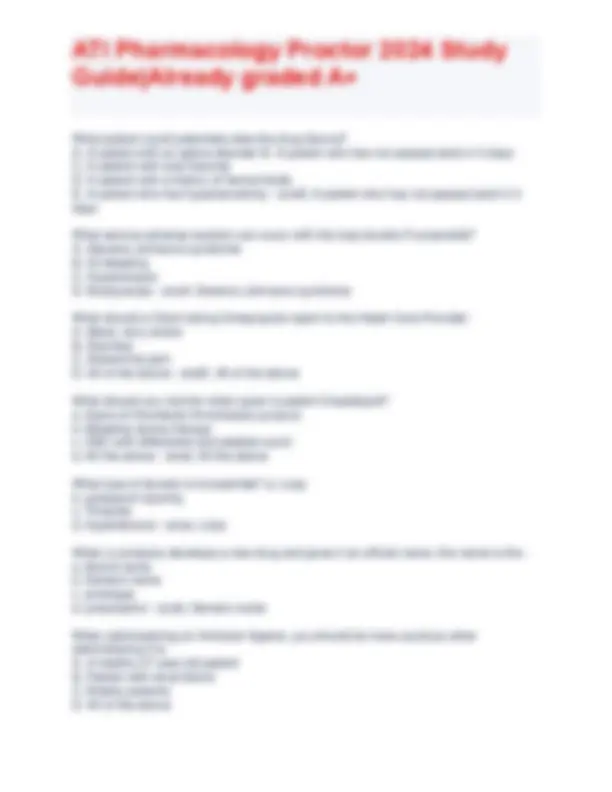
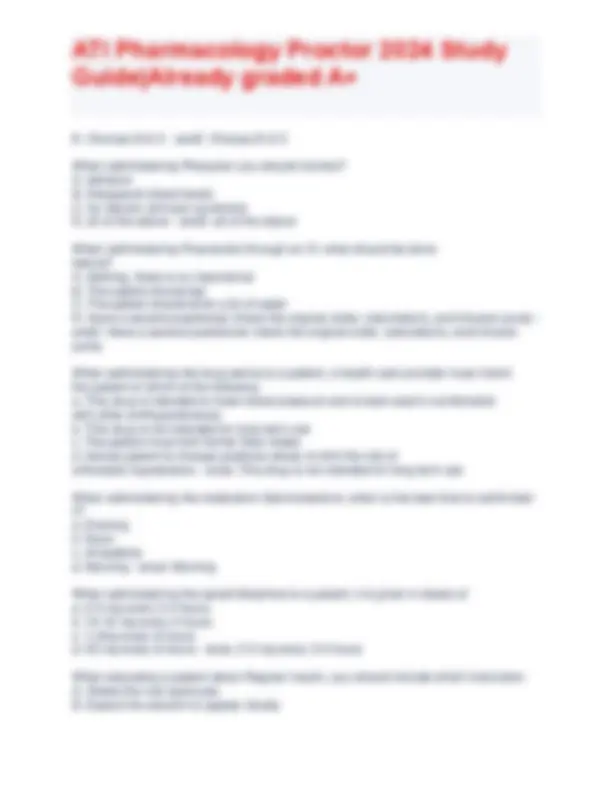
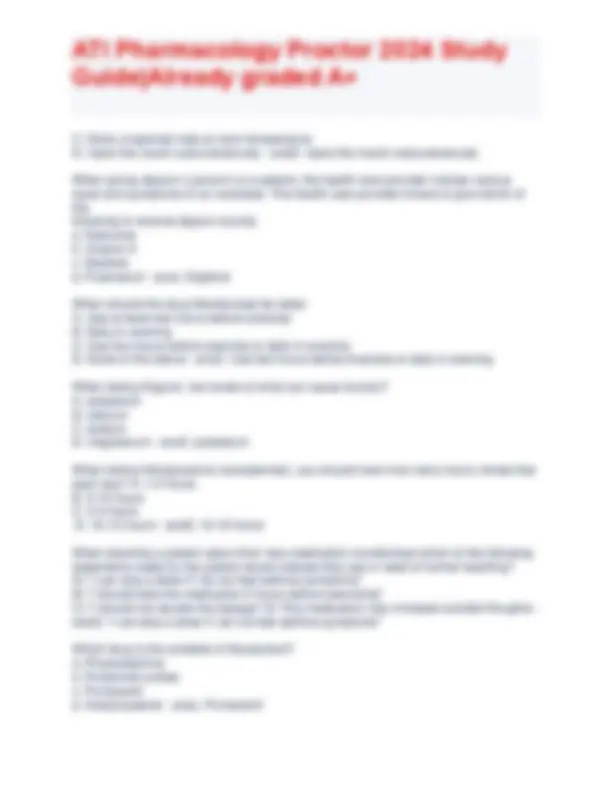
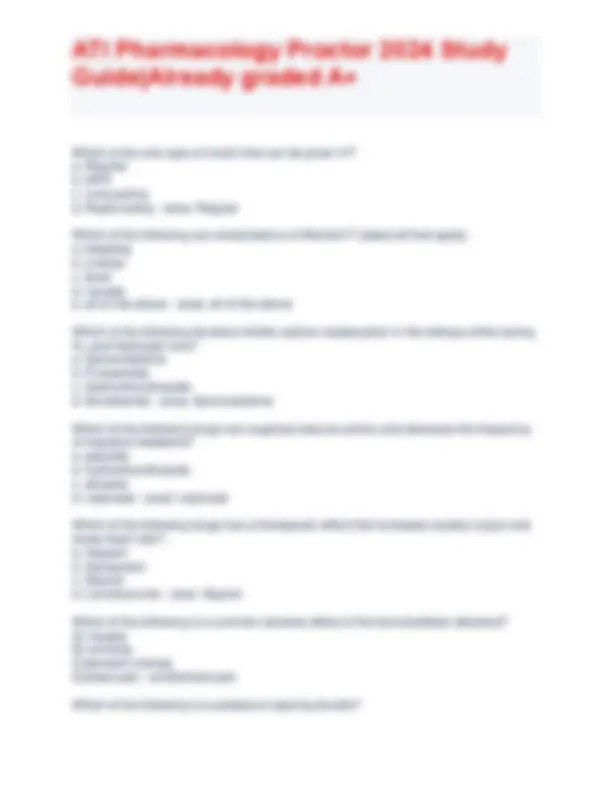
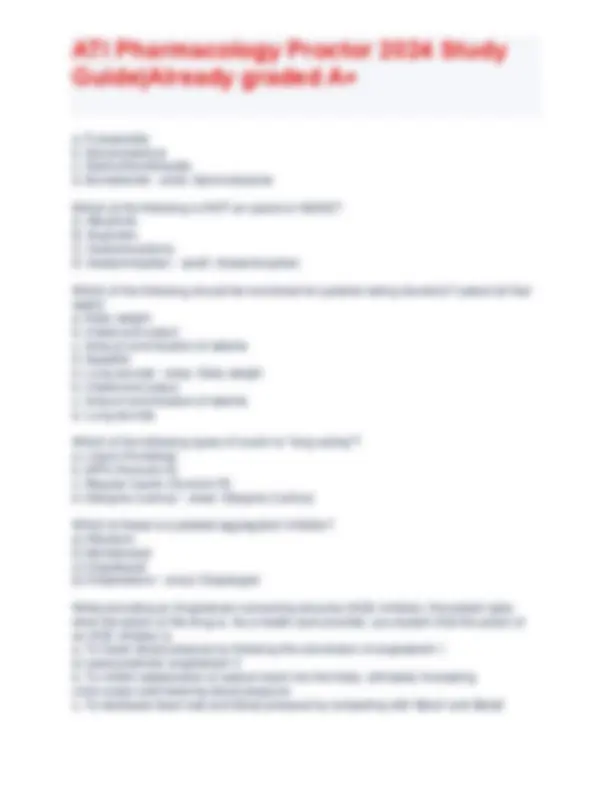
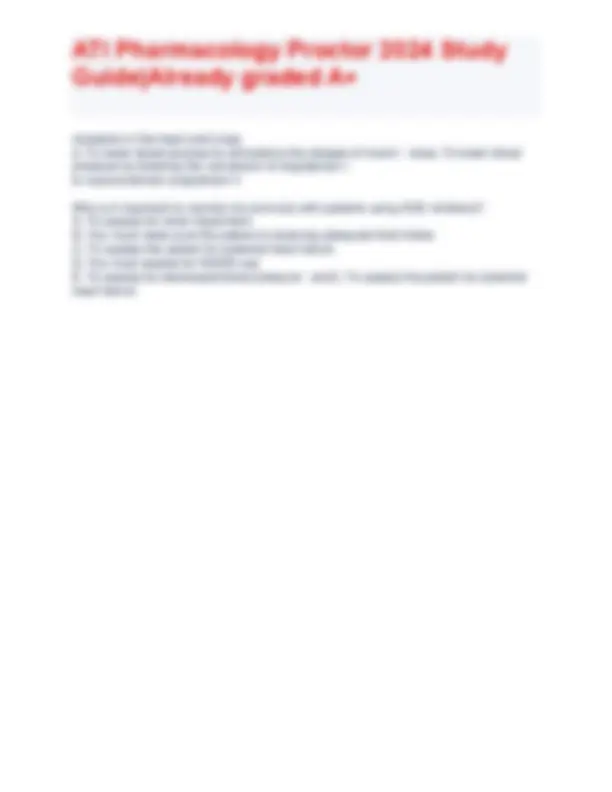


Study with the several resources on Docsity

Earn points by helping other students or get them with a premium plan


Prepare for your exams
Study with the several resources on Docsity

Earn points to download
Earn points by helping other students or get them with a premium plan
Community
Ask the community for help and clear up your study doubts
Discover the best universities in your country according to Docsity users
Free resources
Download our free guides on studying techniques, anxiety management strategies, and thesis advice from Docsity tutors
This study guide offers a comprehensive collection of multiple choice questions and answers covering various pharmacological concepts and medications. It is designed to help students prepare for a pharmacology exam. The guide includes questions on drug actions, adverse effects, therapeutic uses, and nursing considerations for a wide range of medications.
Typology: Exams
1 / 43

This page cannot be seen from the preview
Don't miss anything!




































A nurse is teaching a client who has a prescription for a long-term use of oral prednisone for chronic asthma. The nurse should instruct the client to monitor for which of the following adverse effects? A. Weight Gain B. Nervousness C. Bradycardia D. Constipation - ansA. Weight Gain ) Which drug goes through extensive first-pass hepatic metabolism? A. Heparin B. Insulin C. Propranolol D. Nitroglycerine E. Warfarin - ansC. Propranolol
B. Monitor for seizures. C. Bipolar disorder. D. Migraines.
C. BUN 18 mg/dL D. bounding radial pulse - ansA. urine specific gravity 1. Oliguria, increased urine concentration, and an increase in urine specific gravity greater than 1.030 are expected findings in clients who are dehydrated. A nurse is about to administer Propanolol to a patient. The nurse takes the patient's apical pulse and documents it as 58 bmp. How should the nurse continue? a. Administer the medication as normal b. Cut the tablet in half and administer half of the normal dose c. Give the XR form of the medication d. Withhold administration of the medication and notify physician - ansd. Withhold administration of the medication and notify physician A nurse is administering Adenosine via IV bolus for a client who has developed paroxysmal atrial tachycardia. For which of the following findings should the nurse assess the client during administration of Adenosine? A. seizures B. cinchonism C. dyspnea D. transient pallor of the face - ansC. dyspnea Dyspnea can occur during administration of adenosine due to bronchoconstriction. Since adenosine has a very short half-life of about 10 seconds, this effect should be short-lived. A nurse is administering Ciprofloxacin and Phenazopyridine to a client who has a severe urinary tract infection [UTI]. The client asks why both medications are needed. Which of the following responses should the nurse make? A. phenazopyridine decreases adverse effects of ciprofloxacin hydrochloride B. combining phenazopyridine with ciprofloxacin hydrochloride shortens the course of therapy. C. the use of phenazopyridine allows for a lower dosage of ciprofloxacin hydrochloride D. ciprofloxacin hydrochloride treats the infection, and the phenazopyridine treats pain - ansD. ciprofloxacin hydrochloride treats the infection, and the phenazopyridine treats pain Ciprofloxacin hydrochloride is a broad-spectrum quinolone antibiotic and phenazopyridine is a bladder analgesic/anesthetic that relieves burning and pain in the bladder mucosa caused by bladder spasm and inflammation.
A nurse is administering insulin glulisine 10 units subcutaneously at 0720 to an adolescent client who has type 1 diabetes mellitus. The nurse should anticipate onset of action of the insulin at which of the following times? A. 0800 B. 0745 C. 0900 D. 1030 - ansB. 0745 Insulin glulisine has a very short onset of action of 15 min. The nurse should expect the onset of action around 0745 and ensure the client eats breakfast immediately following administration of the insulin. A nurse is administering oral hydroxyzine to a client. Which of the following adverse effects should the nurse instruct the client to expect? A. diarrhea B. anxiety C. nausea and vomiting D. dry mouth - ansD. dry mouth Hydroxyzine has anticholinergic properties. Dry mouth is a common adverse effect of this medication. The nurse should instruct the client to take sips of water or suck hard candies to minimize this effect. A nurse is administering subQ epinephrine for a client who is experiencing anaphylaxis. The nurse should monitor the client for which of the following adverse effects? a. Hypotension b. Hyperthermia c. Hypoglycemia d. Tachycardia - ansd. Tachycardia A nurse is administering subQ heparin to a client who is at risk for DVT. Which of the following should the nurse take? a. Administer the medication into the client's abdomen b. Inject the medication into a muscle c. Massage the site after administering the medication
c. Nasal congestion d. Visual disturbances - ansb. Proteinuria A nurse is assessing a client who reports using several herbal and vitamin supplements daily, including saw palmetto. The nurse should recognize that saw palmetto is a supplement used by clients to elicit which of the following therapeutic effects A. urinary health promotion B. immune system stimulation C. decreased leg pain from arterial disease D. prevention of nausea caused by motion sickness - ansA. urinary health promotion Saw palmetto is used primarily for manifestations related to prostatic conditions, such as benign prostatic hypertrophy (BPH). Its effectiveness has not been scientifically proven, however. The nurse should teach the client to check with the provider about interactions between saw palmetto and other medications. A nurse is caring for a client and realizes after administering the 0900 medications that she administered digoxin 0.25 mg PO to the client instead of the prescribed digoxin 0.125 mg PO. Which of the following actions should the nurse take first? A. notify the provider B. contact the nursing supervisor C. assess the client's apical pulse D. complete an incident report - ansC. assess the client's apical pulse Caring for this client requires application of the nursing process priority-setting framework. The nurse can use the nursing process to plan client care and prioritize nursing actions. Each step of the nursing process builds on the previous step, beginning with assessment. Before the nurse can formulate a plan of action, implement a nursing intervention, or notify a provider about a change in the client's status, she must first collect adequate data from the client. Assessing will provide the nurse with knowledge to make an appropriate decision. Therefore, the first action the nurse should take is to assess the client. A nurse is caring for a client who had a new prescription for enalapril. The nurse should monitor the client for which of the following adverse effects of this medication? a. Ecchymosis b. Jaundice c. Hypotension d. Hypokalemia - ansc. Hypotension
A nurse is caring for a client who has a new diagnosis of oral candidiasis after taking tetracycline for 7 days. The nurse should recognize that candidiasis is a manifestation of which of the following adverse effects? a. Allergic response b. Superinfection c. Renal toxicity d. Hepatotoxicity - ansb. Superinfection A nurse is caring for a client who has a new prescription for amphotericin B. The nurse should plan to monitor the client for which of the following adverse effects? a. Hyperkalemia b. Hypertension c. Constipation d. Nephrotoxicity - ansd. Nephrotoxicity A nurse is caring for a client who has a new prescription for ergotamine. The nurse should recognize that ergotamine is administered to treat which of the following conditions? a. Raynaud's phenomenon b. Migraine headaches c. Ulcerative colitis d. Anemia - ansb. Migraine headaches A nurse is caring for a client who has a new prescription for tamoxifen. The nurse should recognize that tamoxifen has which of the following therapeutic effects? a. Antiestrogenic b. Antimicrobial c. Androgenic d. Anti-inflammatory - ansa. Antiestrogenic A nurse is caring for a client who has a positive tuberculin skin test and is beginning a prescription for Isoniazid. The nurse should teach the client that which of the following laboratory values should be monitored while taking Isoniazid? A. thyroid stimulating hormone level B. asperate aminotransferase C. potassium D. sodium - ansB. aspartate aminotransferase
d. Isoniazid can cause bladder distention. - ansb. Rifampin can turn body fluids orange. A nurse is caring for a client who has congestive heart failure and is taking digoxin. The client reports nausea and refused to eat breakfast. Which of the following actions should the nurse take first? A. encourage the client to eat the toast on the breakfast tray B. administer the antiemetic C. inform the client's provider D. check the client's apical pulse - ansD. check the client's apical pulse Nausea, anorexia, fatigue, visual effects, and cardiac dysrhythmias, often caused by a slow pulse rate, are possible findings in digoxin toxicity. Caring for this client requires application of the nursing process priority-setting framework. The nurse can use the nursing process to plan client care and prioritize nursing actions. Each step of the nursing process builds on the previous step, beginning with assessment. Before the nurse can formulate a plan of action, implement a nursing intervention, or notify the provider about a change in the client's status, she must first collect adequate data from the client. Assessing will provide the nurse with knowledge to make an appropriate decision. A nurse is caring for a client who has heart failure and is taking oral furosemide 40 mg daily. For which of the following adverse effects should the client be taught to monitor and notify the provider if it occurs? A. nasal congestion B. tremors C. tinnitus D. frontal headache - ansC. tinnitus Loop diuretics, such as furosemide, can cause ototoxicity. The client should be taught to notify the provider if tinnitus, a full feeling in the ears, or hearing loss occurs. A nurse is caring for a client who has peptic ulcer disease and reports a headache. Which of the following medications should the nurse plan to administer? a. Ibuprofen (NSAIDS) b. Naproxen (NSAIDS) c. Aspirin (NSAIDS) d. Acetaminophen (anlagesics) - ansd. Acetaminophen (anlagesics)
A nurse is caring for a client who has prescription for clopidogrel. The nurse should monitor the client for which of the following adverse effects? a. Insomnia b. Hypotension c. Bleeding d. Constipation - ansc. Bleeding A nurse is caring for a client who is at 28 weeks of gestation and is experiencing preterm labor. Which of the following medications should the nurse plan to administer? a. Oxytocin b. Nifedipine c. Dinoprostone d. Misoprostol - ansb. Nifedipine A nurse is caring for a client who is in preterm labor and has a new prescription for Nifedipine. The client states she is concerned because her father takes Nifedipine for his angina pectoris. The nurse should explain to the client that Nifedipine works for clients who are pregnant by which of the following mechanisms? A. it decreases the incidence of bacterial vaginosis, thus preventing uterine contractions B. it inhibits uterine contraction by blocking entry of calcium into uterine cells C. it decreases the activity within the CNS, which regulates all smooth muscles D. it stimulates beta2 receptors in the uterus, which results in decreased frequency of contractions - ansB. it inhibits uterine contractions by blocking entry calcium into uterine cells Nifedipine, a calcium channel blocker, causes uterine relaxation by blocking the flow of calcium to the myometrial cells of the uterus. A nurse is caring for a client who was brought to the emergency department by friends who report the client has overdosed on heroin. Which of the following findings should the nurse expect to assess? A. temperature 39.2 C (102.6 F) B. respiratory rate 30/min C. pinpoint pupils D. severe abdominal cramping - ansC. pinpoint pupils Pinpoint pupils are an expected finding in opioid toxicity. Increased pupil size is seen in opioid withdrawal.
A nurse is planning care for a client who has a seizure disorder and a new prescription for valproic acid. Which of the following lab values should the nurse plan to monitor? Select all that apply. a. BUN b. PTT c. Aspartate aminotransferase (AST) d. Urinalysis e. Alanine aminotransferase (ALT) - ansb. PTT c. Aspartate aminotransferase (AST) e. Alanine aminotransferase (ALT) A nurse is planning care for a female client who has severe irritable bowel syndrome with diarrhea [IBS-D] and a new prescription for Alosetron. Which of the following interventions should the nurse include in the plan of care? A. the client must sign an agreement with the provider before beginning alosetron B. the client must stop taking alosetron if diarrhea continues 1 week after beginning the medication C. the client should expect to have a slower heart rate while taking alosteron D. the client should use a barrier birth control method because alosteron interacts with oral contraceptives - ansC. the client must sign an agreement with the provider before beginning alosteron Alosetron has potentially fatal adverse effects associated with constipation and bowel obstruction. The FDA has allowed alosetron to be placed on the market only if clients sign and adhere to a risk management program, which includes signing a client-provider agreement before starting alosetron. A nurse is planning discharge teaching for a client who has Major Depressive Disorder and a new prescription for Phenelzine. Which of the following foods should the nurse include in the plan as safe for the client to consume while taking Phenelzine? A. broiled beef steak B. macaroni and cheese C. pepperoni pizza D. smoked samon - ansA. broiled beef steak
Phenelzine, an MAOI, is an antidepressant. This medication interacts with a variety of foods to produce a hypertensive crisis. Beef steak and other meats that are fresh do not interact with phenelzine and are safe to consume. A nurse is planning to administer Diltiazem via IV bolus to a client who has atrial fibrillation. When assessing the client, the nurse should recognize that which of the following findings is a contraindication to administration of Diltiazem. A. hypotension B. tachycardia C. decreased level of consciousness D. history of diuretic use - ansA. hypotension Diltiazem can be a treatment option for essential hypertension. This medication will lower blood pressure and is contraindicated for a client who is hypotensive. The nurse should teach the client to self-monitor blood pressure and keep a record of the readings. A nurse is planning to administer Diphenhydramine 50 mg via IV bolus to a client who is having an allergic reaction. The client has an IV infusion containing a medication that is incompatible with diphenhydramine in solution. Which of the following actions should the nurse take? A. choose an IV port for IV bolus injection for the diphenhydramine as near as possible to the client's hanging IV bag B. flush the IV tubing with 2 mL of 0.9% sodium chloride before and after administering diphenhydramine C. allow IV infusion to keep running while administering the diphenhydramine via IV bolus D. aspirate to check the IV patency before administering the diphenhydramine - ansD. aspirate to check for IV patency before administering the diphenhydramine it is important to confirm IV patency prior to administering an IV bolus. Some medications cause severe tissue damage when inadvertently administered into tissue rather than into a vein. A nurse is planning to administer epoetin alfa to a client who has chronic kidney failure. Which of the following data should the nurse plan to review prior to administration of this medication? A. bp B. temp C. blood glucose levels
D. treat shortness of breath with an extra dose of the medication - ansC. schedule the medication on alternate days to decrease adverse effects Some of the adverse effects caused by long-term glucocorticoid therapy, such as suppression of the adrenal gland, can be avoided by using alternate-day therapy. A nurse is preparing to administer ampicillin 50 mg/kg/day PO divided into 4 equal doses for a toddler who weighs 33 lbs. available is ampicillin 125 mg/5ml oral solution. How many ml should the nurse administer per dose? - ans7.5 mL A nurse is preparing to administer ampicillin 500 mg in 50 ml of dextrose 5% in water [D5W] to infuse over 15 minutes. The drop factor of the manual IV tubing is 10 gtt./ml. The nurse should set the manual IV infusion to deliver how many gtt./min? - ans gtt/min A nurse is preparing to administer an IV fluid bolus of 1 L 0.9% sodium chloride over 2 hr. to a client who is dehydrated. The nurse should set the IV pump to deliver how many ml/hr.? - ans500 mL/hr A nurse is preparing to administer Chlorothiazide 20 mg/kg/day PO divided equally and administered twice daily for a toddler who weighs 28.6 lb. The amount available is Chlorothiazide oral suspension 250 mg/5ml. how many ml should the nurse administer per dose? - ans2.6 mL A nurse is preparing to administer codeine 30 mg PO every 4 hr. PRN to a client for pain. The amount available is codeine oral solution 15 mg/5 ml. How many ml should the nurse plan to administer per does? - ans10 mL A nurse is preparing to administer dextrose 5& in 0.45% sodium chloride 400 ml IV to an older adult client over 8 hr. The nurse should set the IV pump to deliver how many ml/hr? (round to the nearest whole number) - ans50 mL/hr A nurse is preparing to administer Digoxin 0.2 mg via IV bolus to a client. The amount available is Digoxin 0.25 mg/1ml. How many ml should the nurse administer? - ans0. mL A nurse is preparing to administer heparin 900 units/hr. via IV infusion. The amount available is heparin 25, 000 units in 500 mL 5% dextrose in water. The nurse should set the IV pump to deliver how many mL/hr? (Round to the nearest whole number) - ans mL/hr
A nurse is preparing to administer iron dextran IV to a client. Which of the following actions should the nurse plan to take? A. administer a small test dose before giving the full dose B. infuse the medication over 30 sec C. monitor the client closely for hypertension after the infusion D. administer cyanocobalamin as an antidote if iron dextran toxicity occurs - ansA. administer a small test dose before giving the full dose A serious adverse effect of iron dextran is anaphylaxis caused by hypersensitivity to the medication. It is recommended that a small test dose be administered over 5 min before giving the full dose. The client should be monitored carefully for an allergic reaction during and for a period of time following the test dose. A nurse is preparing to administer oxytocin to a client who is at 41 weeks of gestation and is experiencing ineffective labor. Which of the following actions should the nurse plan to take? A. place oxytocin from a pre-filled syringe into the posterior fornix of the vagina every 10 min until effective labor occurs B. check the client's bp and pulse every 15 min while induction of labor is occurring C. stop oxytocin for contractions that continue longer than 30 min D. increase the dose of oxytocin to obtain uterine contractions that occur every 2 to 3 min - ansD. increase the dose of oxytocin to obtain uterine contractions that occur every 2 to 3 min Effective uterine contractions should occur every 2 to 3 min. A nurse is providing discharge teaching about lithium toxicity to a client who has a new prescription for lithium. Which of the following statements by the client indicates an understanding of the teaching? A. "I should take naproxen if I have a headache because aspirin can cause lithium toxicity." B. "I can develop lithium toxicity if I eat foods with lots of sodium." C. "I can develop lithium toxicity if I experience vomiting or diarrhea." D. "I might need to take a daily diuretic along with my lithium to prevent lithium toxicity."
A nurse is providing discharge teaching to a client who has been hospitalized for major depressive disorder and has a prescription or Amitriptyline. Which of the following statements by the client indicates an understanding of the teaching? A. I will take amitriptyline in the morning because I'm likely to have trouble falling asleep if I take it in the evening B. I will move slowly when I stand up because amitriptyline can cause my bp to decrease C. I can drink a glass of beer or wine with my evening meal because amitriptyline doesn't interact with alcohol D. I will avoid foods high in fiber because amitriptyline can cause diarrhea - ansB. I will move slowly when I stand up because amitriptyline can cause my blood pressure to decrease Amitriptyline can cause orthostatic hypotension. The nurse should instruct the client to take precautions to prevent injury due to falls while taking amitriptyline. A nurse is providing discharge teaching to a client who has heart failure and a prescription for Digoxin 0.125 mg PO daily and Furosemide 20 mg PO daily. Which of the following statements by the client indicates an understanding of the teaching? A. I know that blurred vision is something I will expect to happen while taking digoxin B. I will measure my urine output each day and document it in my diary C. I will skip a dose of my digoxin if my resting heart rate is below 72 bpm D. I will eat fruits and veggies that have high potassium content every day - ansD. I will eat fruits and veggies that have high potassium content every day Hypokalemia is an adverse effect of diuretic therapy. Because the client is taking digoxin, it is important to maintain the potassium level between 3.5 to 5.0 mg/dL to avoid digoxin toxicity. A nurse is providing discharge teaching to a client who has venous thrombosis and a prescription for warfarin. Which of the following instructions should the nurse include in the teaching? A. Take ibuprofen as needed for headache or other minor pains. B. Carry a medic alert ID card. C. Report to the laboratory weekly to have blood drawn for aPTT. D. Increase intake of dark green vegetables. - ansB. Carry a medic alert ID card.
A client who is taking warfarin is at increased risk for bleeding. In the case of an emergency, it is important that any medical personnel are aware of the client's medication history. A nurse is providing teaching to a client who had rheumatoid arthritis and a prescription for long term prednisone therapy. The nurse should instruct the client to monitor for which of the following adverse effects? a. Stress fractures b. Orthostatic hypotension c. Gingival ulcerations d. Weight loss - ansa. Stress fractures A nurse is providing teaching to a client who has a new prescription for hydrochlorothiazide 50mg po daily to treat hypertension. Which of the following instructions should the nurse include in the teaching? a. Take the hydrochlorothiazide as needed for edema b. Check your weight once each week c. Take the hydrochlorothiazide on an empty stomach d. Take the hydrochlorothiazide in the morning. - ansd. Take the hydrochlorothiazide in the morning. A nurse is providing teaching to a client who has chronic kidney failure with an AV fistula for hemodialysis and new prescription for epoetin alfa. Which of the following therapeutic effects of epoetin alfa should the nurse include in the teaching? a. Reduces blood pressure b. Inhibits clotting of fistula c. Promotes RBC production d. Stimulates growth of neutrophils - ansc. Promotes RBC production A nurse is providing teaching to a client who has cirrhosis and new prescription for lactulose. The nurse should instruct the client that lactulose has which of the following therapeutic effects? a. Increases blood pressure b. Prevents esophageal bleeding c. Decreases heart rate